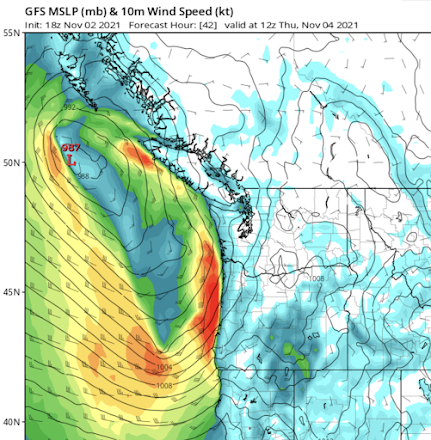For the Northwest, November is the stormiest month of the year by almost every measure.
A month in which strong low-pressure areas or midlatitude cyclones move off the Pacific Ocean towards our region.
The next week is going to be extraordinarily active and it will be a miracle if western Washington or western Oregon escapes one of the big blows.
November is no stranger to major Pacific storms in the Northwest
Let me show you the latest forecast from the most recent NOAA/NWS global model run. On these charts, you will find sea level pressure (solid lines), wind barbs, and wind speed (in knots) shown by the colors. These are sustained winds, averaged over several minutes, not gusts, which are much stronger.
This morning, a modest (994 hPa) low moved up the coast, with very strong winds along the northwestern shores of Vancouver Island.
Thursday morning (5 AM shown), another low moves up the coast, with an associated trough of low pressure bringing strong winds to the Oregon coast.
On Friday morning, ANOTHER low center approaches the BC coast, with strong winds on the south side.
And on Saturday morning, ANOTHER, relatively deep system is moving towards the Washington Coast, with powerful winds from Hoquiam southward.
The most impressive storm is just offshore on Monday afternoon, and it is VERY deep, with a central pressure of 951 hPa. Deeper than the famed Columbus Day Storm. Sustained winds of 50-65 knots. You don't want to know about the gusts.
And this system is heading due eastward, but fortunately weakening as it does so. Still, a major blow on the Oregon Coast.
One rarely sees so many storms reaching our offshore waters over a period of a week. But if it is going to happen, November is the expected month.
There is considerable uncertainty for the later storms, so keep tuned.
But with so much action, so close by, it would not be shocking if one of the storms moves into a favorable position to give Seattle or Portland a major windstorm. And so you know, to really gust around Puget Sound, one needs a strong low-pressure center moving southwest to northeast across the northwest tip of the Olympic Peninsula or the southern section of Vancouver Island (see examples below). If you see that, check your battery supply.








Post a Comment